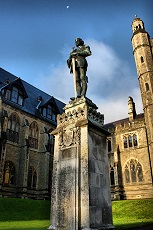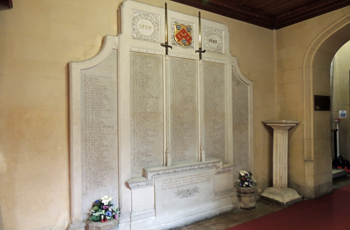



The following is a list with biographies of the 249 people who attended Malvern College and died due to the Second World War. There is also a corresponding page commemorating the 459 casualties in the First World War.
The fallen are commemorated at Malvern with the statue of St. George, which is inscribed 'To Our Brothers', and the names themselves are written on a marble memorial in the Ante-Chapel.
After the Phoney war had ended, there was not a month from May 1940 to May 1945, that an Old Malvernian did not lose their life, though unlike the First World War there were not major spikes in losses on a particular day or month.
5 were killed in the Battle of Dunkirk at the end of May 1940, and 4 during the Battle of Britain between July and October 1940.
3 OMs lost their lives during the Blitz between September 1940 and May 1941.
21 lost their lives in the Western Desert Campaign between June 1940 to February 1943 with 5 buried at El Alamein War Cemetery and 6 commemorated at the Alamein Memorial.
4 were killed during the Allied invasion of Sicily between July and August 1943, and 5 at the Battle of Monte Cassino between January and May 1944 with 8 commemorated at the Cassino Memorial And Cemetery.
8 were killed after the D-Day landings during Operation Overlord between June and August 1944, and 2 in Operation Market Garden in September 1944.
In South-East Asia, 2 were killed during the Japanese-Thai occupation of Malaya between Dec 1941 and Jan 1942, 4 were killed during the Japanese occupation of Singapore in February 1942, and 7 were killed during the Burma Campaign between 1942 and 1945.
Most (97) OMs served in the R.A.F. with many in Bomber Command. 22 are commemorated at Runnymede Memorial as they have no known grave.
14 served in the Royal Navy Volunteer Reserve, 5 in the Royal Navy, 31 in the Royal Artillery, and 4 in the Royal Tank Regiment, with the remainder disbursed among 75 other units.
George Chesterton in the Remembrance Day Service of 2009, having described the lives and loss of five of his friends, reflected:
'Some of these brave men have no known grave, but we must remember them, along with all the tens of thousands of others, who gave their lives for their homelands and their friends. It is thanks to them that all of us sit in this Chapel, from a wide variety of countries and backgrounds and are able to sit together in security and friendship.'
The information below is based on 'The Malvern College Register, Second Supplement, 1949' edited for the Malvernian Society by F. W. Roberts, the 'The Malvernian' school magazine, and 'Malvern College: A 150th Anniversary Portrait' by Roy Allen.
Further information was also obtained from the Commonwealth War Graves Commission website, the Unit War Diaries held at the National Archives in Kew, and various online commemorative websites whose links have been provided.
Below is a map showing the locations of the 126 cemeteries where Old Malvernians are buried or commemorated in. The markers are coloured yellow for one casualty, orange for between 2 and 4, and red for 5 or more. The name of the cemetery and number of casualties can be seen by hovering over the marker, and the list of names seen by clicking on the marker. Their full biographies can be seen by clicking on 'Further Info'.
The records can be filtered and/or sorted by surname, house, age, regiment, date, place etc by clicking on the appropriate drop down box and then the 'Search' button below the map.
Son of K.W.Owen, Upper Maze Hill, St. Leonards.
Sixth Form.
Christ Church Oxford, B.A. 1911. Trial Eights 1909, 1910.
Assistant Master and Secretary to the Strand School, London. Imperial Life Assurance of Canada.
Author of Modern Bridge.
2nd Lieut., Royal Sussex Regt (Special Reserve) June 1914.
1st Gt. War (overseas) A/ Major, Despatches.
2nd Gt. War, Major, General List.
Address: 1 Camley Gardens, Maidenhead, Berkshire.
Killed by enemy action in London, 1941. Died at Brooke's Market, Brooke's Court, Holborn.
Detailed biography at Christ Church, Oxford
Son of R. Mills, 29 Liverpool Rd., Chester.
House Prefect. Football XXII. Cricket XL.
Son of William Morton Eden, 5th Baron Auckland, and of Lady Auckland (nee Hutton).
Husband of Lady Auckland (nee Hart).
'Frederick Colvin George Eden (7.12), Sixth Baron Auckland, was killed in an air-raid on London in April, 1941. He was an Associate of the Institution of Naval Architects, an expert on the taming of wild animals and an air pilot. In the last war he served as a flying instructor. At the outbreak of the present war he joined the R.A.F.V.R. and last year was assistant to the Air Attache in Paris.' (Malvernian, Jul 1941).
'Heavy Casualties and considerable damage were sustained in Wednesday night's air attack on London. The raid, which lasted for almost the whole duration of the hours of darkness, was the most fierce ever delivered on the capital.
The German High Command describes it as a 'reprisal for the British raid on Berlin and Potsdam' last week, and Nazi spokesmen refer to it as of 'hitherto unheard-of dimensions.' The Germans claim that a hundred thousand incendiary bombs were dropped.
Among prominent people killed were Lord Stamp, Chief Economic Adviser, and Lord Auckland, a former Assistant to the British Air Attache in Paris.'
(Dumfries and Galloway Standard, 19 April 1941).
Gravestone photograph
Brookwood military cemetery